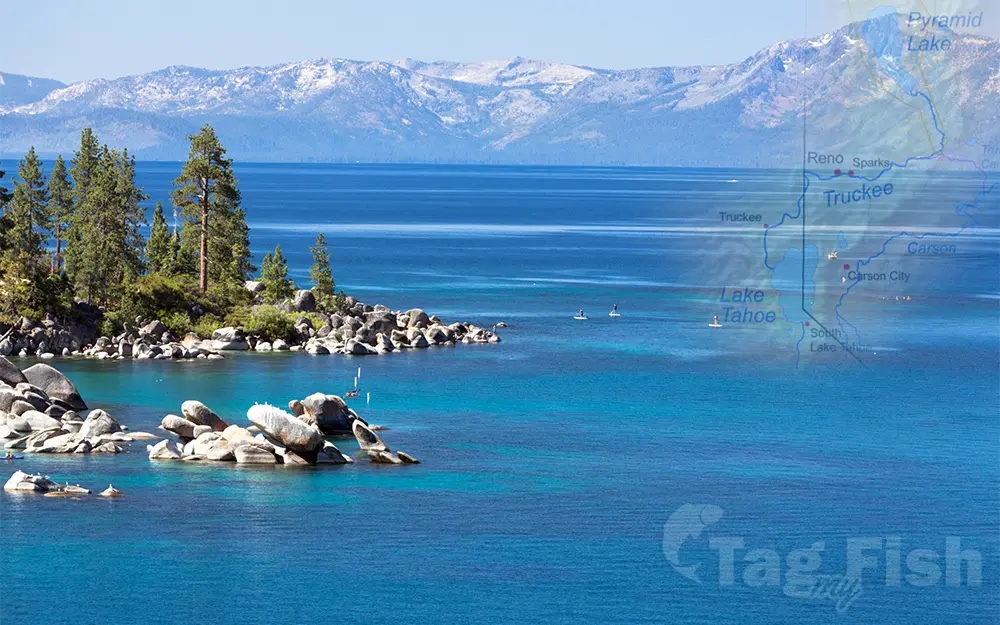Lake Tahoe

General data
- Name: Lake Tahoe
- Water system: Pyramid Lake
- Water type: Natural lake
- Progression: Truckee River -> Pyramid Lake -> Planet Earth
- Climates: Mountain
- Continents: North America
- Countries: United States of America
Lake Tahoe is a freshwater lake in the Sierra Nevada of the Western United States, straddling the border between California and Nevada. Lying at 6,225 ft (1,897 m) above sea level, Lake Tahoe is the largest alpine lake in North America, and at 122,160,280 acre⋅ft (150.7 km3) it trails only the five Great Lakes as the largest by volume in the United States. Its depth is 1,645 ft (501 m), making it the second deepest in the United States after Crater Lake in Oregon (1,949 ft or 594 m). The lake was formed about two million years ago as part of the Lake Tahoe Basin, and its modern extent was shaped during the ice ages. It is known for the clarity of its water and the panorama of surrounding mountains on all sides. Lake Tahoe is a major tourist attraction in both Nevada and California. It is home to winter sports, summer outdoor recreation, and scenery enjoyed throughout the year. Snow and ski resorts are a significant part of the area’s economy and reputation. The Nevada side also offers several lakeside casino resorts, with highways providing year-round access to the entire area. Native fish of the lake include Lahontan cutthroat trout (Oncorhynchus clarki henshawi), mountain whitefish (Prosopiurm williamsoni), Lahontan speckled dace (Rhinichthys osculus robustus), Lahontan redside (Rhinichthys egregious), Lahontan Lake tui chub (Siphateles bicolor pectinifer), Tahoe sucker (Catostomus tahoensis), Lahontan mountain sucker (Catostomus platyrhynchus lahontan), and Paiute sculpin (Cottus beldingi). Most of these fish populations have been significantly reduced due to the introduction of nonnative fish, Asian clam (Corbicula fluminea), and mysid shrimp. Competition from introduced fish led cutthroat trout to be completely extirpated from the lake in the early 20th century until reintroduction efforts started in 2019. Introduced fish species include lake trout (Salvelinus namaycush), rainbow trout (Oncorhynchus mykiss gairdneri), sockeye salmon (Oncorhyncus nerka), brown trout (Salmo trutta), brook trout (Salvelinus fontinalis), common carp (Cyprinus carpio), golden shiner (Notemigonus crysoleucas), western mosquitofish (Gambusia affinis), bluegill (Lepomis macrochirus), black (Pomoxis nigromaculatus) and white (P. annularis) crappie, largemouth (Micropterus salmoides) and smallmouth (Micropterus dolomieu) bass, and brown bullhead (Ameiurus nebulosus). Each autumn, from late September through mid-October, mature sockeye salmon transform from silver-blue color to a fiery vermilion, and run up Taylor Creek, near South Lake Tahoe. As spawning season approaches the fish acquire a humpback and protuberant jaw. After spawning they die and their carcasses provide a feast for gatherings of mink (Neogale vison), bears (Ursus americanus), and bald eagles (Haliaeetus leucocephalus). The non-native salmon were transplanted from the North Pacific to Lake Tahoe in 1944.

 English
English
 Spanish
Spanish
 German
German
 French
French
 Serbian
Serbian
 Russian
Russian

